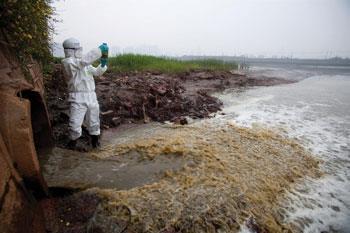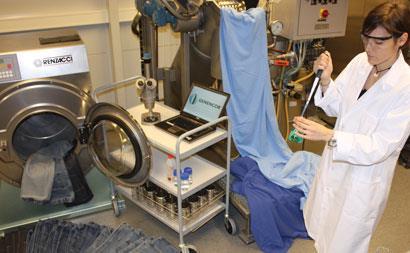Major retailers are starting to consider the environmental impact of the fabric dyeing and finishing processes used by their manufacturers. Fiona Case reports
Major retailers are starting to consider the environmental impact of the fabric dyeing and finishing processes used by their manufacturers. Fiona Case reports
In March this year researchers from the environmental activist group Greenpeace completed a project to collect wastewater samples from two Chinese textile manufacturing facilities which produce clothing for a number of international brands including Abercrombie & Fitch, Calvin Klein and Lacoste. The facilities - located on the Yangtze river and Pearl river deltas - had modern wastewater treatment plants, but gas chromatography-mass spectrometry analysis of their effluent revealed the presence of undesirable compounds including a range of perfluorinated compounds such as perfluorooctanoic acid (PFOA: an environmentally persistent and bioaccumulative chemical with a range of toxic effects), nonylphenol (a persistent material considered to be an endocrine disruptor), toxic dichloroaniline, aminoanthraquinone and aromatic amines including 2-methoxyaniline (a known carcinogen).

’Many persistent organic pollutants will either pass through the conventional wastewater treatment plants unchanged, be converted into other hazardous substances, or accumulate in wastes generated during the treatment process (such as sludges),’ explains Kevin Brigden, a scientist at the Greenpeace Research Laboratories, based at the University of Exeter, UK.
The Greenpeace Dirty Laundry report, published in July, stirred up interest. ’A number of large textile brands are now making commitments to eliminate the use of hazardous chemicals within their supply chains,’ says Brigden. ’What is required to achieve these goals are solutions which progressively replace hazardous chemicals with less hazardous, and preferably ultimately non-hazardous, alternatives.’
Hung out to dry
The perfluorinated compounds (PFCs) probably came from water repellent textile finishes. ’PFOA seems to be particularly problematic and one solution is to switch to the C6 material,’ says Martin Bide from the department of textiles at the University of Rhode Island, US. ’In 2006 the US Environmental Protection Agency approached the eight largest fluorocarbon producers and requested a 95 per cent reduction in PFOA use by 2010, and 100 per cent by 2015. The major companies have responded and have already transitioned their textile finishing products to short-chain chemistry.’
Use of these new materials would reduce the PFOA in the effluent, but Brigden is not satisfied. ’The shorter chain PFCs also have properties of concern, and have already been found to bioaccumulate in the wild. The goal needs to be the elimination of PFCs.’
P2i, a company focusing on liquid repelling nanocoating technology based in Abingdon, UK, is taking a step in that direction, according to its chief technical officer Stephen Coulson. ’We apply fluorinated acrylates to surfaces using plasma technology,’ he says. The technology was developed to provide maximum water and oil repellency for military clothing. Acrylate monomers with fluorocarbon side chains are fed into the plasma. They deposit on the surface and polymerise. ’We are only using tiny amounts of material - the final coating is only nanometres thick - and material that is not coated onto the product is entirely contained,’ Coulson explains. ’Conventional chemistries such as PFOA are not required and there are no issues with waste.’ P2i are now coating more than 1.5 million pairs of high-end shoes per year for brands such as Timberland, Mizuno and Teva, and are in discussions with several clothing brands.
Nonylphenol in the wastewater almost certainly resulted from the degradation of nonylphenol ethoxylate (NPE) surfactants. It did not need to be there. ’The use of NPEs in textile manufacture is no longer permitted within the EU, which clearly demonstrates the ability to manufacture textiles without them,’ says Brigden. ’It is unfortunate that NPE use continues in other locations, and that many brands allow their products to be manufactured using these substances.’
Dyeing to be green
Dyes are typically large aromatic molecules with delocalised orbitals of appropriate energy to absorb photons with wavelengths between 400 and 700nm. The charge on the molecule and its substituents define the type of dye and the materials on which it will be used.
The first synthetic dye was discovered serendipitously in 1856 by the young William Perkin while he was trying to make quinine. Perkin’s mauve was a water-soluble cationic dye. This class is still used for dying acrylic fibres (the proposed mechanism is salt formation with anionic groups on the fibres). Cellulosic fibres such as cotton, viscose, or lyocell are often dyed using reactive dyes. As their name implies, the chromophore is attached to a group such as a halogenated heterocycle or an activated double bond which reacts with the hydroxide group on cellulose. Because they are chemically bonded the reactive dyes have excellent colour fastness, however some of the older materials can have fixation rates as low as 50 per cent. Half of the dye ends up in the waste stream. A wide range of techniques including micro- and nano-filtration, photocatalytic oxidisation, sorption methods and bioreactors have been used to remove the bright colours from the effluent. ’The last example I saw used plasma-treated onion skins,’ comments Bide. But a better approach is to optimise the chemistry.
’We provide a range of dyes which have combinations of several, often different, reactive groups on each chromophore,’ explains Patrice Carreau, director of technology and project management at Huntsman Textile Effects (headquartered in Singapore). ’The dyes all have identical kinetics of absorption and reaction - so that the final colour created by a mixture is consistent throughout the fabric. The light- and water-fastness must also be consistent so that the colour remains true as the fabric is worn and washed.’
Huntsman aims to optimise both the exhaustion rate of the dye (the amount of dye that is absorbed onto the fibre) and the fixation rate (the amount of dye that ends up chemically bonded to the fibre). ’In the past as much as 25 per cent of the physically absorbed dye did not chemically bond. This material ended up in the wash bath, six to eight baths at high temperature were necessary to remove it. For our new dyes three or four baths at 60?C are sufficient. More than 90 per cent of the dye ends up chemically bonded to the fabric,’ explains Carreau.
Sulfur dyes used to be the main choice for dark black shades on cotton. In a classic sulfur dyeing process the S-S bonds are reduced with Na2 S producing soluble dye anions which absorb into the fibre and are reoxidised to their insoluble form. While some dye suppliers have managed to greatly reduce the release of environmentally problematic sulfides in effluent, others recommend moving to reactive dyes. Wool, silk, and nylon have traditionally been coloured using acid dyes, large multicyclic aromatic molecules with anionic sulfonyl or amino functionalities, applied in an acidic dye bath. These materials are often mordanted with chromium - which is of considerable concern in wastewaters. ’We abandoned chrome dyes a long time ago, although they may still be used in other parts of the world,’ says Carreau. ’The new reactive dyes provide colours that are even deeper than the chromes on wool or the sulfur dyes on cotton.’
Alenka Majcen Le Marechal is a professor at the University of Maribor, Slovenia. She studies the effluent from the textile industry as part of the European Aquafit4Use project. She is still concerned about reactive dyes. ’They are not dangerous in themselves, but their synthesis involves precursors and side products that are toxic.’ The dichloroaniline and aminoanthraquinone observed by Greenpeace could have come from this source. ’We are seeing increasing amounts of these toxic materials in the final product, particularly in recent years as the production of textile dyes has moved from the EU to other countries,’ she says. ’These impurities can be released into wastewater during textile finishing, or even during home laundering.’

Cellulosic fibres are also dyed using vat dyes. The insoluble chromophore is reduced to its colourless, but water-soluble form and absorbs into the fabric. Once the fabric is removed from the bath the material rapidly oxidises back to its coloured form. ’The dye molecule isn’t the issue for this system. More than 90 per cent of the material agglomerates within the fibre,’ says Thomas Bechtold, professor at the Research Institute for Textile Chemistry and Textile Physics, University of Innsbruck, Austria. ’But there is no way to recover reducing agent in current processes. A typical reducing agent is dithionite. We use electrochemistry to reoxidise this material and membrane filters to concentrate it so that it can be reused. I am convinced that this approach has potential,’ he says.
Catalytic clothing
Technologies are being developed to mitigate the negative impact of textile manufacture, but can our clothes make a positive impact on the environment?
Tony Ryan, pro-vice chancellor at the University of Sheffield, UK, believes they can. Working with artist and designer Helen Storey he hopes to convince us all to wear clothing coated with nanoparticles of TiO2, so that together we can make a significant reduction in NOx pollutants.

Air pollution is a significant problem. It is estimated to reduce the life expectancy of every person in the UK by an average of 7-8 months. ’I calculated the surface area of the fibres making up my suit and realised that clothes could be a catalyst support with high specific surface area. Coating TiO2 onto the surface of clothing fabrics at the same surface density as photocatalytic architectural coatings could make a significant difference,’ says Ryan. ’One square metre of wall can take out 0.5g NOx a day so even with 3/4 of the coated fibres in the dark we can anticipate a person wearing catalytic clothing taking out at least a gram of NOx a day.’
Tom Domen, long term innovation manager for the ecologically sound cleaning products firm Ecover, Belgium, has been working with Ryan’s team. ’We have already started work on a laundry product - we are leaning towards a one-time softener-like additive,’ he says. ’We have treated textiles in laundry and we are determining the optimum amount of TiO2 to add. We will then send the product to be tested for its NOx removing ability. We still have a lot of R&D to do, but we also need to talk to the consumers to decide how to present the concept.’
To promote their work, the team is planning a number of artistic installations of TiO2 -coated clothing during 2012, including the their Field of Jeans in Durham in March, and exhibiting a crop of kilts at the Edinburgh International Science Festival. ’We are also hoping to gather a group of catalytic clothing users together in London during the Olympics and use satellite NOx imaging to see the difference that they make to the air that surrounds them,’ says Domen.
More environmentally distressed
Indigo, the dye used for jeans, is a less substantive example of a vat dye. But, after successfully adsorbing the dye in the fabric, denim manufacturers proceed to remove some of it again, at considerable environmental and ethical cost (several brands banned sandblasting earlier this year because of the outcry about workers exposed to silica dust).
’In denim only the surface of the warp (the vertical fibres in a final pair of jeans) is dyed,’ explains Bechtold. ’Mechanical stress removes the surface leaving a fashionable faded appearance.’
Some higher-end jeans brands use cellulase enzymes to break down the surface of the fibres, releasing some of the dye. This provides a more environmentally friendly method to produce a soft, worn-in appearance. Bechtold proposes applying a paste of NaOH to activate the fibre surface before the enzyme washing. ’This enhances the enzyme activity in specific areas,’ he explains. ’It can provide the desired pattern of wear while preserving the strength of the fabric.’
Finally, the ’azo dyes’ and the likely source of 2-methoxyaniline: ’A significant percentage of dyes contain azo groups as part of their delocalised structure,’ says Bide. ’Azo dyes are generally considered to be non-toxic, some are permitted as food colours. The issue which has given these materials bad press is the potential cleavage of the azo group and the aromatic amines that result. The dyes that cleave into any of 22 potentially carcinogenic aromatic amines, including the 2-methoxyaniline found by Greenpeace, are banned in Europe.’
Greener processing
The environmental impact of the textile industry goes beyond the release of toxic materials. ’The industry uses 9 trillion litres of water annually and 1 trillion kilowatt hours of electricity,’ says Scott Brix, director of global marketing for Genencor’s textiles group. ’It’s responsible for 10 per cent of the world’s carbon impact,’ he adds.

Genencor uses bioengineering to produce novel enzymes for textile processing steps such as desizing. ’Sizing agents such as starch or carboxymethyl cellulose are added to protect fibres during the weaving process. Traditionally sizing has been removed with hot water, acid or ? enzymes to solubilise and break down the starches into dextrins,’ Brix explains.
While enzymatic desizing has been practiced for years, it is now also possible to achieve enzymatic scouring at the same time, he adds. Scouring is done to enhance wettability and remove waxes and other impurities. ’Scouring with neutral pectate lyase can release materials trapped on the cotton under the same conditions as desizing enzymes and sometimes even in the same bath, thus saving water. Using these specially engineered enzymes can save upwards of 30 per cent water and 60 per cent energy usage compared to standard processing.’
Eco-bleaching
’Cotton bleaching with peroxide is carried out at 95?C and a pH of 12 or higher. This was clearly a target for improving the process,’ says Erwin Redling, head of application and screening technology at Huntsman. Genencor and Huntsman have together pioneered a biochemical bleaching process, again relying on enzyme catalysis. The enzyme, an acyltransferase, adds peroxide to a masked acid - for example propylene glycol diacetate - producing the powerful oxidising agent peracetic acid. It is this reagent that breaks the extended conjugated chemical bonding in a chromophore so that it becomes colourless, or else absorbs light outside the visible spectrum. ’It is possible to reduce energy consumption by almost half due to the considerably lower treatment and rinsing temperatures. No neutralisation is required and at least one or two rinsing baths can be omitted, reducing water usage.’ The new process is also gentler on the fibre. ’Under normal bleaching conditions, 9 or 10 per cent of the fibre is lost. With the gentle bleach system we only see 4 to 5 per cent weight loss, and the handle is clearly better,’ says Redling.
The textile industry has one of the most complex supply chains. If brands or retailers, such as Walmart or Marks and Spencers, wish to make environmental claims about the products they sell, they need to control the environmental cost at each stage of production. This may be particularly challenging for ’manufacturers without factories’ that generally design and market - but do not make - their products. ’A couple of years ago brands would never have dreamed of telling their manufacturers what to do,’ says Brix. ’They are starting to be more forceful in asking. They know that they can’t continue to support producers that may be polluting or wasting resources without enraging customers. They generally welcome people like us stopping by to suggest how they can reduce their carbon footprint.’
Fiona Case is a science writer based in Vermont, US






No comments yet